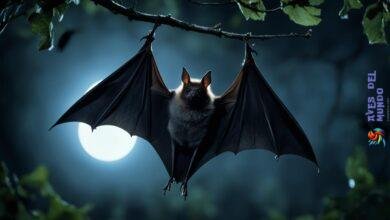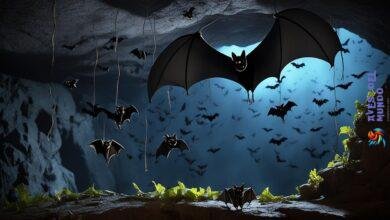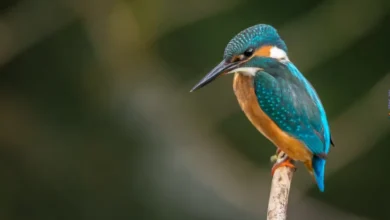Did you know that there are over 200 species of owls alone, making them one of the most common examples of nocturnal birds worldwide? These nighttime aviators, including the distinct Owl (Bubo bubo) and the formidable American Eagle Owl (Bubo virginianus), possess keen adaptations for life under the cloak of darkness. As you find comfort in the stillness of night, nocturnal avian species like the enigmatic Kiwi (Apteryx mantelli) and the vigilant Night Heron (Nycticorax nycticorax) awaken, transforming the night into a symphony of survival and instinct.
Each species offers a glimpse into the intricate tapestry of nocturnal ecosystems, where feathers brush silently against night skies and every chirp signifies a living pulse thrumming through the shadows. Uncover the mysteries that flutter in the moonlight as we delve into the fascinating world of birds who prefer the stars over the sun, and find out why these nocturnal creatures are far more than just denizens of the dark—they are essential threads woven into the very fabric of nature.
Understanding Nocturnal Birds and Their Unique Adaptations
When the sun sets, a different world awakens. Among the creatures of the night are those winged specters, the nocturnal birds, whose lives are perfectly attuned to the dark hours. You might wonder how these birds manage to navigate and survive when the world goes dark. The key lies in their remarkable adaptations, which manifest in various aspects of their anatomy and behavior.
Nocturnal vs. Diurnal: The Night Shift in Avian Species
Nocturnal birds adaptations have evolved enabling them to make the most of the night-time avian behavior that sets them apart from their diurnal counterparts. While diurnal birds are busy during the day, nocturnal species, like the wise old owls, have perfected the art of the night shift.
Anatomical and Sensory Traits Facilitating Nocturnal Lifestyle
These night-time adventurers are equipped with impressive sensory enhancements. Key among these are their expanded eyes, designed to capture even the faintest glimmers of light. This ocular advantage ties into an increased ratio of rod cells, aiding their vision in low-light environments. Such adaptations are crucial, as they must detect, chase, and capture their prey in the absence of sunlight.
The Significance of Camouflaged Plumage in Night Birds
During the day, nocturnal birds rely heavily on their camouflaged feathers to stay hidden from potential threats. Their plumage bears patterns that blend seamlessly into their surroundings—a mosaic of browns, grays, and other muted tones mimic the bark of trees or the forest floor. This natural cloak is as essential for their survival as their nocturnal skills.
| Adaptation | Function |
|---|---|
| Enhanced Vision | Predation and navigation during night |
| Camouflaged Feathers | Concealment from predators during rest |
| Acute Hearing | Locating prey via sound |
| Silent Flight | Stealth approach towards prey |
As dusk turns to night, these birds display a symphony of adaptations that allow them to reign supreme under the cover of darkness. Whether it’s silently swooping down on an unsuspecting mouse, or avoiding the gaze of a predator, their specialized traits make each night a testament to their evolutionary success. So, next time the moon casts its silver glow, ponder the nocturnal birds and their dance with the shadows—a spectacle of survival that has been perfected over millennia.
The Significance of Owl Species in Nocturnal Habitats
As the sun sets and the cloak of darkness blankets the sky, a fascinating transformation unfolds in the wilderness. This is the time when the enigmatic figures of the owl species, like the Great Horned Owl, Barn Owl, and Barred Owl, emerge as the sovereigns of nocturnal hunting. With incredible adaptability, these avian predators master the darkness, making each silent flight a testament to their prowess in the night-time ecosystem.
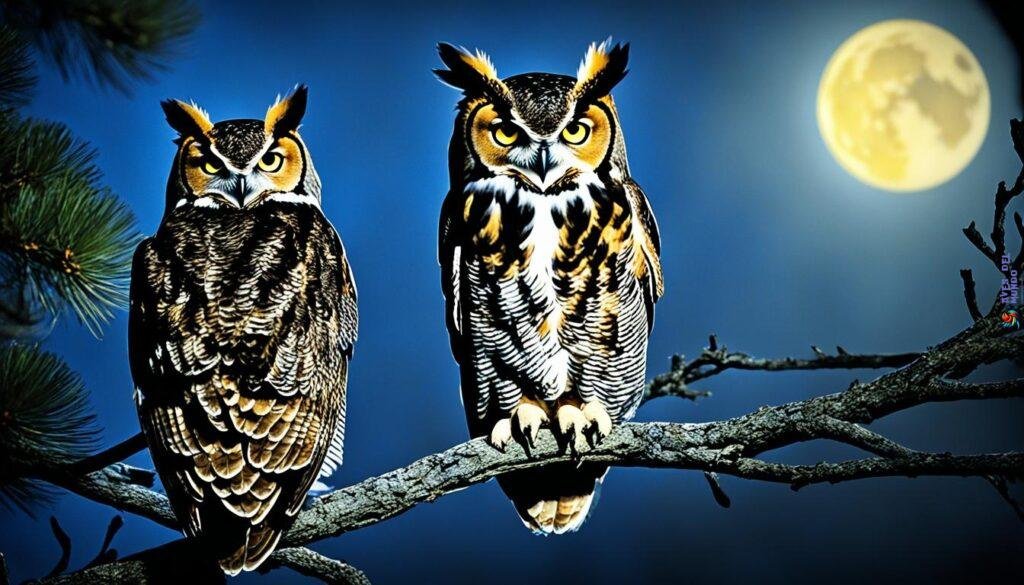
Spotlight on the Mysterious Great Horned Owl
The Great Horned Owl, known for its formidable silhouette, exemplifies the essence of nocturnal hunting. With deep camouflaged feathers blending seamlessly into the nightly backdrop, it watches intently with piercing eyes, utilizing its acute hearing to detect the faintest rustle of prey in the underbrush.
Barn Owl: Masters of Silent Nocturnal Hunting
Almost ethereal in appearance, the Barn Owl’s unique adaptations set it apart. The bird’s heart-shaped facial disc channels sounds directly to its finely-tuned ears, allowing it to navigate and locate prey effortlessly through echolocation, even on the darkest of nights.
Unisex Nocturnal Activity: The Case of the Barred Owl
Not to be overshadowed, the Barred Owl incorporates a different strategy in the nocturnal hunting play. With a barred plumage that melds into the woody habitat, it is distinguished by unisex nocturnal hunting, where both males and females share in the quest for sustenance, showcasing their versatility in nocturnal life.
| Owl Species | Distinct Features | Hunting Behavior |
|---|---|---|
| Great Horned Owl | Powerful talons, tufted ears, camouflage | Uses auditory prowess, swoops silently down on prey |
| Barn Owl | Heart-shaped facial disc, silent flight | Hunts in complete darkness, relying on sound |
| Barred Owl | Streaked feathers, large dark eyes | Employs both sight and sound in dual-gender hunting |
The existence of these owl species extends beyond mere predatory roles; they are guardians of the nocturnal realms, keeping delicate ecosystems in balance. It is your multifaceted relationship with nighttime—a seamless blend of silent flights and pinpoint accuracy—that maintains their status as emblematic figures in the world of nocturnal hunting.
Rare Nocturnal Flyers: The Elusive Night Parrot and Kakapo
When night falls, the animal kingdom bursts into a flurry of unseen activity. Within this cloak of darkness, the Night Parrot (Pezoporus occidentalis) and the Kakapo (Strigops habroptilus) emerge as two of the most enigmatic figures. These nocturnal parrots have captured the imagination and concern of ornithologists worldwide. Their allure lies not just in their elusive nature, but in their rarity, marking them as two of the most extraordinary rare avian species sharing our planet.
This nocturnal duo has mastered the art of concealment. The Night Parrot, believed to have been extinct for over a century, remains a ghostly presence within Australia’s vast interior, its survival strategies a testament to its adaptability. Meanwhile, across the Tasman Sea, the Kakapo secures its legacy as the world’s only flightless nocturnal parrot, known for its distinctive «boom» chorus that punctuates the stillness of New Zealand’s nights.
In the silent wilderness, the Night Parrot and the Kakapo are whispers of an ancient avian line, a reminder that not all of nature’s marvels soar on the open wing, but rather glide through the shadows of obscurity.
Here’s a comparison of these two remarkable species to provide a better understanding of their unique characteristics:
| Characteristic | Night Parrot (Pezoporus occidentalis) | Kakapo (Strigops habroptilus) |
|---|---|---|
| Habitat | Dense shrublands of Australia | Forest areas of New Zealand |
| Physical Adaptation | Camouflaged, yellow-green plumage | Camouflaged, greenish-yellow plumage; flightless |
| Notable Behavior | Nocturnal, crepuscular; rarely seen | Nocturnal, «parachutes» from trees, known to ‘boom’ |
| Conservation Status | Critically Endangered | Critically Endangered |
You might wonder just how these nocturnal parrots have managed to escape attention for so long. With survival instincts honed over millennia, they avoid predators under the cloak of night, making their activity hard to document. Yet, as they stride through our world’s darkened niches, they have become symbols of conservation, their precarious status urging us to preserve the quiet corners of our planet they call home.
Efforts to protect these birds continue, as researchers and conservationists work to unravel the mysteries that shroud their existence. In doing so, they shine a light on the broader issue that faces all rare avian species. The preservation of the Night Parrot and the Kakapo is not just about saving two species—it’s a rallying cry for the protection of biodiversity at large.
Nocturnal birds: Unveiling the Mysteries of Nighttime Aviators
As the sun sets and darkness envelops the landscape, a fascinating shift occurs in the avian world. The stillness of the night is subtly pierced by the enchanting activities of nocturnal birds, each playing a crucial role in the intricate tapestry of nocturnal ecology. With adept predatory techniques and behaviors fine-tuned for survival, species such as the Nightjar (Caprimulgus europaeus), the Stone Curlew (Burhinus oedicnemus), and the Kiwi with its renowned nocturnal habits, become the protagonists of the night.
The Secret Lives of Nightjars: Masters of Disguise
The Nightjar (Caprimulgus europaeus) is a spectral presence in the twilight, its mottled plumage a masterclass in camouflage. As dusk fades to night, these remarkable birds take to the skies in silent flight, their eyes and ears finely attuned to the slightest movements of insect prey. Yet, by day, they transform into unassuming elements of the forest floor, a critical adaptation for eluding predators.
Understanding the Predatory Techniques of Stone Curlews
Stone Curlews, equipped with large, glowing yellow eyes, dominate the darkened landscape with their keen vision, allowing them to identify prey with lethal precision. Their unique vocal calls pierce through the stillness of the night, a signal of their dominance in the dark. These birds exemplify the remarkable predatory techniques necessary for nocturnal success.
How the Kiwi’s Nocturnal Habits Support New Zealand’s Ecology
Meanwhile, the Kiwi embodies the essence of nocturnal adaptation. With its finely honed sense of smell and sturdy, probing beak, it forages nocturnally, playing an indispensable role in seed dispersal and soil aeration. The Kiwi’s nocturnal habits are not merely a quirk of evolution but a keystone of New Zealand’s unique ecology, reflecting the interconnectedness of life after dark.
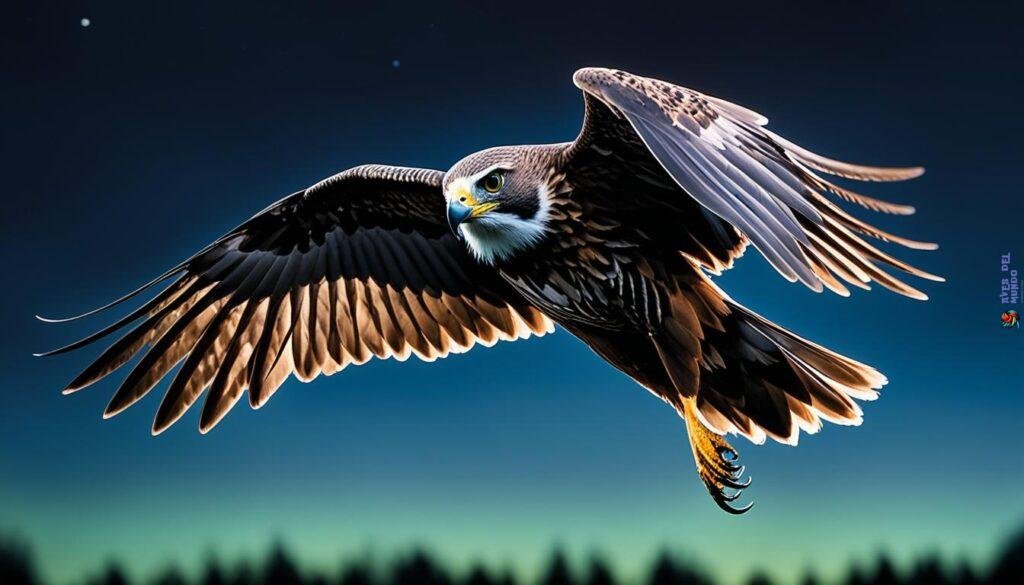
Let’s delve deeper into the nocturnal world of these birds by comparing some of their key attributes:
| Species | Habitat | Hunting Style | Conservation Status |
|---|---|---|---|
| Nightjar (Caprimulgus europaeus) | Woodlands and heathlands | Aerial insectivore | Least concern |
| Stone Curlew (Burhinus oedicnemus) | Open fields and scrublands | Ground forager | Near threatened |
| Kiwi (Apteryx spp.) | Native forests and shrublands | Ground forager using olfactory cues | Vulnerable to critically endangered |
Understanding these nocturnal creatures not only fascinates us but also informs conservation efforts. By appreciating the roles of these nighttime aviators, you become an ally in the quest to preserve the delicate balance of nocturnal ecology.
Discovering the Unique Behaviors of Frogmouths After Dark
When dusk falls, the Tawny Frogmouth (Podargus strigoides) begins its remarkable transformation from unassuming daytime percher to a master of nocturnal insect hunting. You may be familiar with the iconic vision of owls as synonymous with nighttime predation, but the Tawny Frogmouth possesses its own distinct Frogmouth species behavior that is equally intriguing and effective.
Contrary to popular belief, the Tawny Frogmouth doesn’t hoot like its owl cousins; it instead employs a strategy of absolute stealth and patience. Adapting to the nocturnal lifestyle, it sits perfectly still on a branch, almost indistinguishable from the bark, and waits for unsuspecting insects to come within range. With a burst of precision, it captures its prey with its wide, frog-like mouth—hence its name.
Behold the Tawny Frogmouth—a testament to the adaptability and diversity of nocturnal aviators. Its understated majesty lies in its elusive nature and the specialized role it plays within its habitat.
| Behavior | Adaptation | Benefit |
|---|---|---|
| Camouflaged Resting | Mottled Plumage | Daytime Predation Avoidance |
| Statuesque Stillness | Minimal Movement | Superior Ambush Hunting |
| Wide-Mouthed Capture | Large Gape | Efficient Insect Consumption |
| Low-Vibration Vocalization | Deep, Soft Calls | Courtship and Territory Defense |
Whether you’re an avid birdwatcher or a curious nature enthusiast, understanding the Tawny Frogmouth’s nocturnal rituals adds another layer of appreciation for the complexity of our ecosystem. Next time you venture out after dark, remember to look up—you might just spot a Tawny Frogmouth in action, a silent sentinel in the night.
Exploring Crepuscular Birds: Dusk and Dawn Specialists
As you delve into the world of bird behavior, the term ‘crepuscular’ may not be as commonly known as ‘nocturnal’; yet it defines a unique group of birds that are most active during the twilight hours. Crepuscular birds, such as Nighthawks and the enchanting Nightingales (Luscinia megarhynchos), have adapted to thrive in the low-light conditions of dusk and dawn, creating a distinctive niche in the avian world.
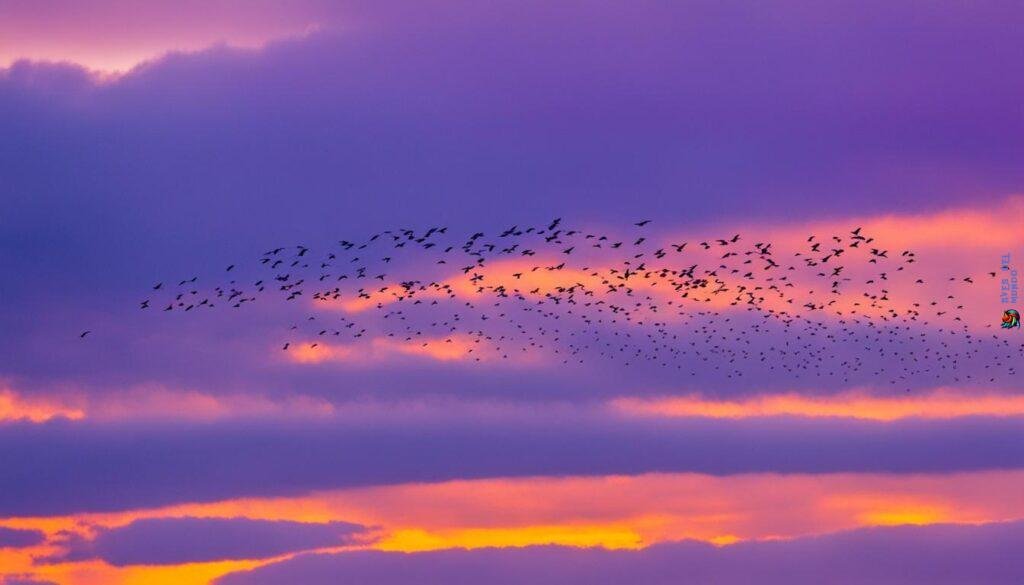
The Transitional Activity of Nighthawks and Nightingales
Nighthawks, with their sweeping flights at twilight, capitalize on dusk and dawn activity to feed and partake in aerial displays. These crepuscular birds are exemplary for their ability to navigate the skies when the sun’s rays barely touch the horizon. Similarly, the revered Nightingales not only grace the air with their melodic tunes for mating rituals but also reveal their zest for life in these mercurial hours that are neither fully light nor dark.
Crepuscular Versatility: Thriving at Twilight
Understanding the versatility of crepuscular birds such as Nightingales requires an appreciation for their capacity to adjust swiftly between day and night. These birds hold mastery over the ephemeral windows of dusk and dawn, ensuring they can exploit the advantages offered by both daylight and the cover of night. Their activity during these periods exemplifies the intricacies of avian life cycles and behavior.
| Species | Dawn Activities | Dusk Activities |
|---|---|---|
| Nighthawks | Returning to roost after nocturnal feeding | Commencing evening foraging; twilight insect hunting |
| Nightingales (Luscinia megarhynchos) | Singing to attract mates; defending territory | Increase in vocalization; seeking safe roosts |
Whether you’re an avid birdwatcher or someone curious about the subtle intricacies in the avian domain, recognizing the behavior of crepuscular birds enriches your understanding of the natural world. As you start to observe the environment during these quiet yet active transitional times, you might just find yourself enveloped in the serene yet lively world of the birds that call twilight their prime.
Protect and Preserve: Conservation Efforts for Nocturnal Bird Species
As the sun sets, a diverse range of avian species come to life, performing their daily activities under the cloak of darkness. These unique adaptations, however, also render them particularly vulnerable to anthropogenic threats. You have the power to make a difference in nocturnal bird conservation. Increasing urbanization and light pollution are steadily eroding the habitats necessary for the survival of these magnificent creatures. To counteract these threats, international wildlife organizations and local communities are joining forces to ensure robust habitat preservation.
In addition to scientific research, public education plays an indelible role in protecting the endangered avian species that dot our night skies. Conservation includes a multifaceted approach – from advocating for the minimization of disrupting artificial light to safeguarding breeding grounds. Taking action, whether by supporting policy changes or contributing to habitat restoration projects, can lead to substantial benefits for these nocturnal birds. Consider how decreased pesticide use can bolster their survival, or how preserving dark sky areas can facilitate their nocturnal routines. Each measure you support contributes significantly to the delicate balance of our ecosystem.
By learning about the nocturnal wonders of our world and participating in local conservation efforts, you are actively helping to maintain the magical symphony of the night.
- Supporting land preservation can create sanctuaries where these nocturnal birds can flourish.
- Engaging in community science projects enhances tracking and data collection, allowing for informed conservation strategies.
- Choosing eco-friendly lighting and campaigning for responsible development can mitigate harmful light pollution that disorients nocturnal birds.
Remember, the actions taken to protect nocturnal birds and preserve their habitats are vital, not only for the biodiversity of our planet but also for the health of our environment. To maintain the chorus of night, let us champion the cause of combating the decline of these night-time wanderers, ensuring their mysterious calls continue to grace the darkened skies of future generations.
The World of Water and Night: Black-Crowned Night Heron’s Dual Life
The enigmatic Black-Crowned Night Heron (Nycticorax nycticorax) is a captivating presence in the twilight hours, embodying a seamless blend of aquatic prowess and nocturnal mystery. As you observe their subtle movements at the water’s edge, it’s clear that these birds are uniquely adapted for life in both the still of the night and the ebb and flow of watery realms.
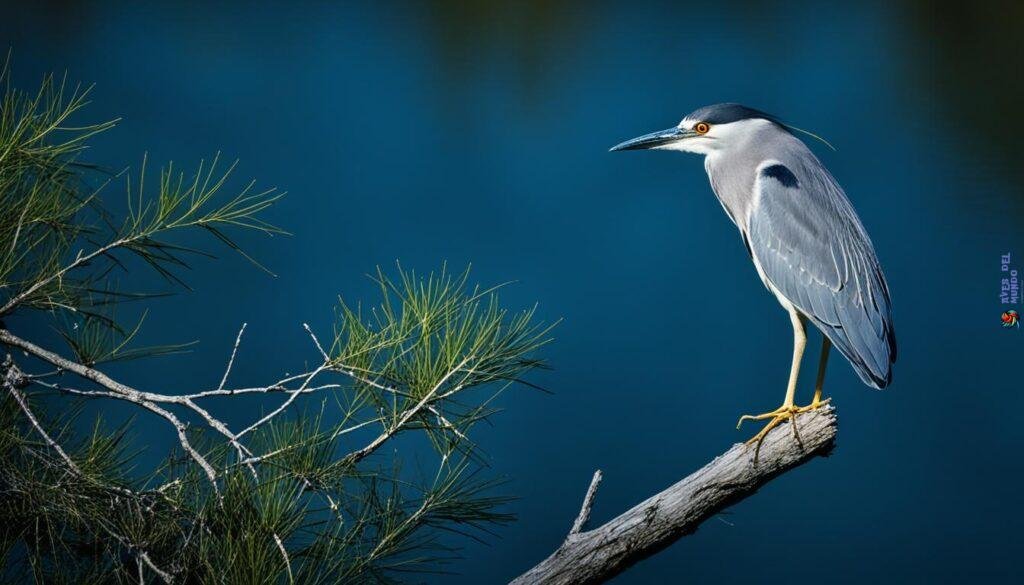
Adaptations for Aquatic Nocturnal Hunting in Herons
One cannot overstate the importance of aquatic hunting adaptations in the survival and success of the Black-Crowned Night Heron. This bird’s stout physique allows for a patiently poised hunting stance. Shorter legs and a compact neck, uncharacteristic for herons, enable a swift strike into the water. The heron’s large eyes, like moonlit globes, magnify the minimal light available at night, ensuring no prey slips by unnoticed.
The Role of Black-Crowned Night Herons in Ecosystems
Understanding the heron’s ecosystem role invites appreciation for the careful balance maintained within aquatic habitats. The Black-Crowned Night Heron dutifully regulates populations of fish and amphibians, ensuring a dynamic equilibrium. By day, their roosting in trees offers a different service, contributing to the ecosystem through their interactions with other bird species and the environment itself. It’s a testimony to the heron’s versatility and resilience in the face of nature’s ever-shifting tableau.
Guided by Sound: How Nocturnal Birds Utilize Acoustics
When the sun sets and darkness envelops the sky, nocturnal avian species come alive, masterfully navigating the night. They engage in sound-guided hunting, an evolutionary marvel allowing them to locate prey with remarkable accuracy. Key to their survival is the sophisticated use of acoustic navigation, a skill that permits these creatures to thrive in the still of the night.
Your understanding of these fascinating creatures is not complete without appreciating their reliance on sound over sight. It’s a world where the rustle of leaves or the faint scurrying of a mouse dictates the boundary between a successful hunt and a night of hunger for these skilled predators.
Imagine you are a Barn Owl, perched silently in the dead of night. Your world is pitch-black, but your ears are alive with the sounds of nocturnal life. Every crunch and whisper of the forest floor travels to you, painting a picture of your surroundings clearer than any image.
The feat of pinpoint locating prey is not unique to the Barn Owl but is shared across species engaging in sound-guided hunting. This ability is so refined that some species can detect a moving target with precision, even in complete darkness.
Consider the table below, illustrating the various nocturnal birds and the methods they use to harness acoustics for survival:
| Nocturnal Bird Species | Acoustic Hunting Techniques | Primary Sense Used in Hunting |
|---|---|---|
| Barn Owl (Tyto alba) | Facial disc channels sound | Hearing |
| Great Horned Owl (Bubo virginianus) | Deep camouflaged feathers mute flight | Hearing and sight |
| Nightjar (Caprimulgus europaeus) | Whisper-quiet flight for undetected movement | Hearing |
| Kiwi (Apteryx mantelli) | Keen sense of smell, sensitive whiskers | Smell and touch |
To fully grasp the significance of these adaptations, it is essential to recognize that acoustic navigation does more than just facilitate hunting; it defines the ecological niche that these nocturnal avian species occupy. The silent flight of an owl or the near-invisible presence of a nightjar grants these birds an unparalleled advantage in the nightly arms race for survival.
- Examine the way owls use their head rotations to triangulate sounds.
- Observe the silent sweeping flight of a nightjar as it hunts.
- Notice the subtle rustling that betrays a rodent’s location to a patiently waiting kiwi.
These experiences allow you to witness first-hand the marvel of sound-guided hunting amongst these remarkable nocturnal hunters. The next time you find yourself outside after dusk, pause and listen—perhaps you’ll gain a small insight into the acoustic world these birds navigate each night.
The Night Shift: Predatory Techniques of Nocturnal Feeders
As the sun sets, a fascinating transformation occurs in the natural world. Nocturnal feeders emerge, employing a myriad of nocturnal feeding strategies designed specifically for predation under darkness. The cover of night provides these creatures with the perfect backdrop to execute their hunting practices, which are as varied as the species themselves.
Strategies for Nocturnal Hunting Across Bird Species
The art of nocturnal hunting is an evolutionary marvel. Owls, with their silent flight, exemplify the stealth needed for nocturnal predation. Using acute hearing and low-light vision, they can pinpoint and snatch up unsuspecting prey. Conversely, nightjars take to the skies, their wings slicing through the air as they perform dazzling feats of aerial acrobatics to capture insects on the wing.
The Vespertine Birds: Embracing the Veil of Darkness
Vespertine birds, those active during the evening hours, exhibit unique vespertine behavior that allows them to exploit the fleeting light. In this dim environment, they find their niche, with heightened senses guiding their pursuit for food. As dusk turns to night, these birds adeptly adjust their techniques to succeed in the darkest hours.
| Species | Hunting Strategy | Adaptation | Active Period |
|---|---|---|---|
| Owls | Silent swoop and strike | Acute hearing, low-light vision | Night |
| Nightjars | Aerial insect hunting | Maneuverability, wide mouth | Dusk to dawn |
| Vespertine birds | Sunset foraging | Transition vision, quiet flight | Evening |
Flightless Night Wanderers: Understanding Ground-Dwelling Species
When you think of nocturnal avians, your mind might soar with the image of an owl gliding silently through the dark forest. However, some of the most captivating nocturnal creatures are not found in the sky, but closer to the ground. Flightless nocturnal birds such as the Kiwi (Apteryx mantelli), the Kakapo (Strigops habroptilus), and the secretive Night Parrot (Pezoporus occidentalis) evade predators and forage for their meals under the blanket of night.
The Kiwi, New Zealand’s avian icon, exhibits a suite of nocturnal adaptations. With its keen sense of smell and whisker-like feathers, the Kiwi hunts for worms and insects by night, guided by its olfactory powers—a rarity among birds. Similarly, the Kakapo, also from New Zealand, treads the forest floor at night. This bird is the world’s only flightless parrot, and it has an intriguing approach to mating, performing a deep, resonant ‘boom’ that echoes through the night to attract a mate. Lastly, Australia’s Night Parrot remains one of the most enigmatic of all. It skillfully navigates the outback dusk using its excellent night vision and finely-tuned hearing.
Understanding these flightless nocturnal birds is essential not only for our sense of wonder but also for their conservation. Let’s take a closer look at each of these unique species:
| Species | Habitat | Diet | Nocturnal Activity |
|---|---|---|---|
| Kiwi (Apteryx mantelli) | Forests and farmlands | Invertebrates, seeds, fruits | Foraging and burrow maintenance |
| Kakapo (Strigops habroptilus) | New Zealand’s Podocarp forests | Herbs, fruits, seeds, pollen | «Booming» mating calls and feeding |
| Night Parrot (Pezoporus occidentalis) | Arid and semi-arid grasslands | Seeds and fruits | Foraging and possibly nesting |
Each of these birds plays a critical role in their respective ecosystems. Not only do they contribute to the biodiversity of their habitats, but they also provide insights into the evolutionary paths that have enabled certain species to adapt to nocturnal life on the ground, rather than in the air.
Conservation efforts are crucial in ensuring that these unique flightless nocturnal birds do not vanish into the annals of history, becoming nothing but whispers in the night. Every step you take towards understanding their plights brings light to the shadowy world they inhabit and helps secure a future where the night continues to be alive with their distinctive calls and behaviors.
Nightly Vocal Performances: The Songbirds That Sing After Sundown
As dusk settles and the hustle of the day quiets down, a remarkable ensemble begins among nocturnal avians. Your evening walks are often graced by the Nightingales (Luscinia megarhynchos) nocturnal singing, creating an enchanting atmosphere that resonates with their desire to find a mate. Their melodic sequences are not just random chirps, but a sophisticated communication tool essential for courtship and the continuation of their species.
Nightingales and Their Nocturnal Melodies: A Nighttime Symphony
Captivated by the charismatic performances of the night-time bird songs, research reveals that the Nightingale’s repertoire consists of over 250 different song variations. These melodious tunes serve as sonic landscapes in the dead of night, each one distinct, with a rhythm and pitch tailored to transcend the stillness of their nocturnal realm.
Decoding the Moonlit Serenades of Mockingbirds
Equally notable are Mockingbirds (Mimus polyglottos) vocal performances, a testament to their complex and adaptable singing behaviors. Unlike Nightingales, Mockingbirds are not just crooning for mates; they might also be claiming their territory or warning others of potential dangers. Their concerts can last for hours, incorporating a variety of imitations from other birds and sounds in their environment, showcasing their exceptional vocal abilities.
In your search for tranquility or the sublime experience of nature’s music, consider lingering in places where these birds are known to reside. From nearby parks to the edges of woodlands, night-time bird songs provide a natural backdrop that few man-made instruments can replicate. And as you listen, remember the complex social and biological purposes interwoven within each note that travels through the darkened skies.
Under the Moonlight: Nesting and Breeding Behaviors of Nocturnal Birds
As you delve into the nocturnal world, you’ll find that the night sky does more than just serve as a backdrop for the stirring activities of night-active birds. The dark hours are a time for critical life events, particularly nesting habits and breeding strategies. These behaviors are exquisitely attuned to nocturnal rhythms, ensuring the prospering of species in a world unseen by many. The Night Parrot, shrouded in mystery due to its elusive nature, synchronizes its reproduction with the lunar cycle, embodying the celestial influence on the winged night dwellers.
Your journey through the shadows will also reveal the unique breeding strategies of birds like the Kakapo. This flightless parrot’s breeding season is largely dictated by the availability of food sources at night, highlighting a practical response to environmental cues. Such adaptations are seminal for the continuation of these species and showcase the delicate balance between nocturnal activity and survival. The nocturnal breeding patterns do more than ensure offspring; they reinforce the intricate tapestry of life that exists under cover of night.
The nesting habits of these creatures further emphasize their commitment to thriving in the darkness. Secure and concealed nests are vital for the daytime when these birds are most vulnerable. Understanding these multifaceted nighttime behaviors can illuminate the wider ecological roles nocturnal birds play and underscore the urgency in safeguarding their habitats. Indeed, their unseen lives are paramount to the nocturnal symphony and the biodiversity it entwines.
